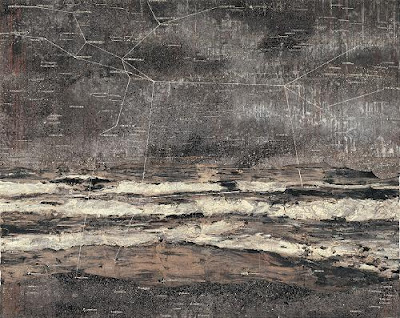
Caspar David Friedrich (1774-1840) - The Sea of Ice, 1824

Gerhard Richter (b. 1932) - Seascape (Cloudy), 1969

Anselm Kiefer (b. 1945) - Andromeda, 2001
1. 'We are standing at the edge of all the religions which have sprung from Catholicism. The abstractions are declining, everything is airier and lighter than that which has gone before. Everything strives towards landscape, searches for something certain in this uncertainty and does not know how to being. Those who reach back for history are wrong and only confuse themselves. Is then this new art - Landschafterey, if you want to call it that - not capable of reaching a pinnacle which will be even more beautiful than that of the previous art?'
2. 'When above me the sky swarms with with countless stars the wind blusters through the wide space, the wave breaks roaring in the wide night, over the forest the atmosphere reddens, and the sun lights up the world; the valley steams, and I throw myself on the grass sparkling with dewdrops. Every leaf and every blade of grass swarms with life, the earth is alive and stirs beneath me, everything rings in one chord, then the soul rejoices and flies in the immeasurable space around me. There is no up and no down any more, no time, no beginning and no end . . .'
3. 'This perception of the relationship of the whole universe to us; this joyful delight in the most intimate, vivid spirit in our soul; this unifying harmony, which in its buoyancy touches every string in our heart . . . We hold fast to the consummation of these feelings and in this way certain thoughts arise in us.
We express these thoughts in words, tones, or pictures and thus inspire the same feelings in the hearts of men near us.'
4. 'His work should not be for himself and his friends simply a picture, not merely a work of art, but rather should transmit the experience of nature, its processes and laws.'
5. 'The preset situation would lead much more towards the arabesque and hieroglyphs; and it is only from these that landscape must come forth - even as historical compositions also came from them . . .
It is necessary for one who wishes to express a magnificent concept through symbols and hieroglyphs, particularly if one desires to make such expressions public, that one considers the hieroglyphics as mere words which have been understood for some time and that they should be used in a new way, much like a musician who plays his instrument without being conscious of how he holds it. But if one tries to enjoy every individual aspect of the work and explain each note to others, then he will block himself off from the vital energy of the picture.'
1. 'We are standing at the edge of all the religions which have sprung from Catholicism. The abstractions are declining, everything is airier and lighter than that which has gone before. Everything strives towards landscape, searches for something certain in this uncertainty and does not know how to being. Those who reach back for history are wrong and only confuse themselves. Is then this new art - Landschafterey, if you want to call it that - not capable of reaching a pinnacle which will be even more beautiful than that of the previous art?'
2. 'When above me the sky swarms with with countless stars the wind blusters through the wide space, the wave breaks roaring in the wide night, over the forest the atmosphere reddens, and the sun lights up the world; the valley steams, and I throw myself on the grass sparkling with dewdrops. Every leaf and every blade of grass swarms with life, the earth is alive and stirs beneath me, everything rings in one chord, then the soul rejoices and flies in the immeasurable space around me. There is no up and no down any more, no time, no beginning and no end . . .'
3. 'This perception of the relationship of the whole universe to us; this joyful delight in the most intimate, vivid spirit in our soul; this unifying harmony, which in its buoyancy touches every string in our heart . . . We hold fast to the consummation of these feelings and in this way certain thoughts arise in us.
We express these thoughts in words, tones, or pictures and thus inspire the same feelings in the hearts of men near us.'
4. 'His work should not be for himself and his friends simply a picture, not merely a work of art, but rather should transmit the experience of nature, its processes and laws.'
5. 'The preset situation would lead much more towards the arabesque and hieroglyphs; and it is only from these that landscape must come forth - even as historical compositions also came from them . . .
It is necessary for one who wishes to express a magnificent concept through symbols and hieroglyphs, particularly if one desires to make such expressions public, that one considers the hieroglyphics as mere words which have been understood for some time and that they should be used in a new way, much like a musician who plays his instrument without being conscious of how he holds it. But if one tries to enjoy every individual aspect of the work and explain each note to others, then he will block himself off from the vital energy of the picture.'
Philipp Otto Runge (1777-1810)